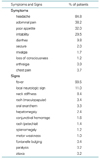Abstract
Aseptic meningitis, an acute inflammatory process of the meninges, is characterized by pleocytosis and absence of microorganisms on Gram stain and routine bacterial culture of CSF, and commonly occurs in children. Although aseptic meningitis occurs sporadically all the year round, in areas of temperate climates as in Korea, most cases occur in summer and fall, and the large scale epidemics draw a great deal of social concerns. Among the various etiologies, enteroviruses are the causative agents in about 85% of all cases. Although the clinical course is self-limited in most instances, substantial morbidity and mortality may be observed in some cases. In dealing with the patients of suggestive aseptic meningitis, it is important to rule out the diseases that are fatal but treatable.
References
1. Cherry JD. Feigin RD, Cherry JD, editors. Enteroviurses: coxsackieviruses, echoviruses, and polioviruses. Textbook of pediaric infectious diseases. 1998. 4th ed. Philadelphia: WB Saunders;1787–1839.
2. Morag A, Pgra PL. Behrman RE, Kliegman RM, Jenson HB, editors. Enteroviruses. Textbook of Pediatrics. 2000. 16th ed. Philadelphia: WB Saunders;956–964.
3. Rotbart HA. Enteroviral infections of the central nervous system. Clin Infect Dis. 1995. 20:971–981.

4. Strikas RA, Anderson LJ, Parker RA. Temporal and geographic patterns of isolates of nonpolio enterovirus in the United States 1970-1983. J infect Dis. 1986. 153:346–351.

11. Adair CV, Gauld RL, Smadel JE. Aseptic meningitis, A disease of diverse etiology : clinical and etiologic studies on 854 cases. Ann Intern Med. 1953. 39:675–704.

12. Dagan R, Hall CB. Epidemiology and laboratory diagnosis of infection with viral and bacterial pathogens in infants hospitalized for suspected sepsis. J pediatr. 1989. 115:351–356.

13. Norris CM, Danis PG, Gardner TD. Aseptic meningitis in the newborn and young infant. Am Fam Physician. 1999. 59:2761–2770.




 PDF
PDF ePub
ePub Citation
Citation Print
Print






 XML Download
XML Download